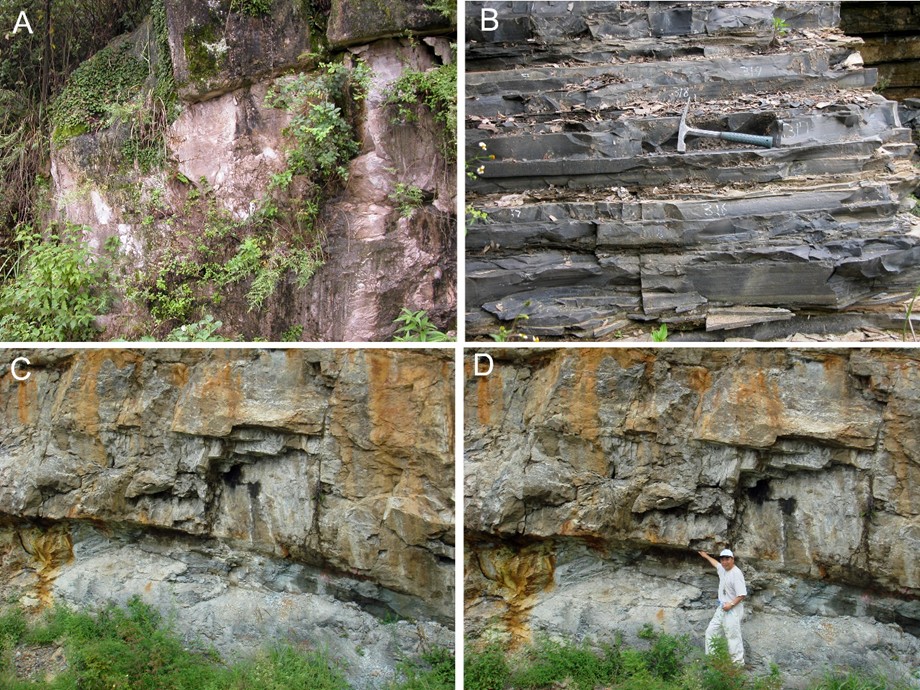Tongying Fm
Type Locality and Naming
NOTE: See Dengying Fm (Ediacaran entry; which is the most-commonly used name). There is an uncertainty about the upper-age limit among authors; therefore Peng Shanchi (Cambrian Lexicon compiler) submitted the following entry for Tongying Fm with the interpretation that the "Tongying Fm" extended into lower part of Cambrian Stage 2. However, the schematic stratigraphic columns by Gao Linzhi et al. (Neoproterozoic Lexicon compilers) interpreted the "Dengying Fm" as terminating at the base of Cambrian.
The type locality of the Töngying Formation is the Qingshubao section, measured between Shipai and Nantuo villages on the south bank of the Yangtze (Changjiang) River (111°09’41”E, 30°49’ 42”N), about 20 km northwest of the seat of Yichang City, western Hubei Province. The section was remeasured by Zhao et al. (1985). The Töngying Formation was named by Li and Zhao (1924). The name is derived from Töngying (spelled Dengying in Hanyu Pinyin) Gorge on the Yangtze (Changjiang) River, near Yichang, western Hubei Province. Originally it was called Töngying Limestone and was renamed Töngying Formation by the Section on Precambrian Geology and Metamorphic Rocks, Chinese Academy of Geological Sciences (1962). This formation spans Ediacaran-Cambrian boundary.
Synonym: Dengying Fm, Töngying Fm, (灯影组); The upper part of the Töngying Fm in Yunnan has been named Yuhucun Fm (Yuhucun chert-bearing Quartzite) by Wang (1941), Meishucun Fm by Jiang et al. (1964), and Zhujiaqing Fm by Zhu et al. (2001). The former two formations had been abandoned by Zhang (1996), and the last has almost the same concept with either Yuhucun Fm (in narrow sense) or Meishucun Fm and should be also abandoned.
Lithology and Thickness
The Tongying Formation is a carbonate sequence. It was divided into three parts: Lower part consists of greyish white, thick-bedded dolomite breccia. Middle part consists of black thin-bedded bituminic limestone containing chert bands and nodules. Upper part consists of greyish white, thick to mega-thick-bedded dolomite containing chert beds and concretions. In the type section, the formation is 863.42 m thick.
[Figure: The massive and thick-bedded dolomite and the thin-bedded limestone of Töngying Fm, near Yanjiahe, eastern Yangtze Gorge, Yiling District, Yichang, western Hubei Province, South China. A, massive dolomite (Cambrian System) in the upper part of the formation; B, thin-bedded limestone (Cambrian System) in mid-upper part of the of the formation; C, D, Contact relationship between the Töngying Fm (thick-bedded dolomite, Ediacaran System) at the base of the formation and the underlying Toushantuo Fm (black thin-bedded, fine-crystalline dolomite, Ediacaran System). The boundary is pointed by the author, Peng Shanchi; C is close-up view of D.]
Relationships and Distribution
Lower contact
The Tongying Fm rests conformably on the underlying Doushantou Fm (Toushantou Fm) of early through middle Ediacaran.
Upper contact
It is disconformably overlain by the Niutitang Fm in the type section. However, the formation can be also in conformable with overlying Niurtutang Fm in some other sections.
Regional extent
The Töngying Formation is exposed in the Yangtze Area, the Jiangnan Slope and the Jiangbei Slope areas of South China Region, and the northeastern corner of Qiangtang-Simao Region, distributed in eastern Yunnan, Guizhou, Sichuan, Hubei, southern Henan, southern Anhui, southern Jiangsu, northern Jiangxi, northern and western Zhejiang provinces, and Chongqing Municipality. The thickness of the formation varies from place to place. For example, in Hubei Province the thickness varies from 26 to 1812 m; in eastern Yunnan from 129.6 to 1720.4 m; and in northern Jiangxi from only 26 to 80 m.
GeoJSON
Fossils
The Tongying Formation yields micro-paleoplant fossils Asperatopsophosphacera partialis, A. cf. partialis, A. umishanensis, Fuchunshania rarojugata, Hubeisphaera radliata, Laminarites sp., Leiofusa aff. digitata, Leiopsophashaera sp., Lophosphaeridium sp., Lophominuscula sp., Margominuscula verrucosa, M. sp., Micrhystridium sp., Monotrematosphaeridium cf. asperum, Polyporata sp., Pseudozonosphaera asperella, P. aff. asperella, P. verrucosa, Quadratimorpha sp., Taeniatum sp., Trachysphaeridium hyalimum, T. rude, T. sp., Trematosphaeridium minutum, and T. cf. holtedahlii. It also yields priapulids Micronemaiites sp., Saarina sp. and Scolithus sp. and algae Tyrasotaenia cf. podolica and Vendotaenia sp.
Age
Depositional setting
